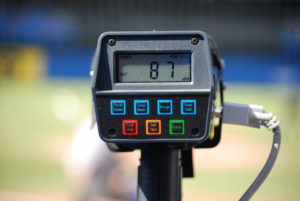Losing Velocity In-Season
The in-season period can be a difficult time for some athletes as the demands of playing and practicing can make maintaining a training effect difficult. Some athletes will not train at all during the season which leads to significant dips in strength and power, causing poor performance or injury. Their poor training habits are compounded by practices being at a relatively low intensity, so athletes are not doing anything at full speed. Pitchers are rarely throwing at max effort other than on game days, and if they’re relievers this may be fine because they’re pitching frequently. But, if they’re starters, throwing hard once per week may not be enough to prepare their bodies for competition, making a well-planned in-season throwing program extremely important for maintaining velocity and health.
Another factor in velocity dips is nutrition. With practices and games taking up a majority of their time, athletes tend to eat poorly and not eat as much. Since greater lean mass is associated with greater pitching velocity (Yamada et al., 2013), this can be a problem if they’re losing a significant amount of weight.
Along with poor nutrition and individual training habits, some coaches make maintaining velocity even harder by “conditioning” their pitchers like cross country runners. Distance running makes it difficult to maintain body weight, as well as strength and power, and too many coaches have their pitchers run poles at practice or after they pitch. There are better ways to help them recover than having them run distance, such as mobility circuits, sprints with proper rest periods, or arm care protocols.
Movement Screens Are A Must!
The first thing I do after a new athlete signs up (after the health history and other paperwork) is take them through a movement screen. The screening process allows me to see postural and mobility issues that can lead to pain and diminished performance. If you don’t screen athletes this way, it’s impossible to individualize their program and you may include movements in their programs that are totally wrong for them. For example, if I have an athlete who has poor shoulder mobility, internally rotated shoulders, and poor upward rotation, overhead pressing and barbell bench pressing are probably the wrong choices for them. They will be better served doing movements that allow for free movement of the scapulae, horizontal pulling variations, and scapular control/lower trap/serratus anterior exercises such as a foam roller wall slide (see video below).
Resources
Photo:
“Radar Gun on a Lincoln off-speed pitch.” by James G CC BY 2.0
Yamada et al., Whole-body and segmental muscle volume are associated with ball velocity in high school baseball pitchers. Open Access J Sports Med. 2013; 4: 89–95. Published online 2013 Apr 4.


